Floating Power Plant Market Research, 2032
The global floating power plant market size was valued at $10.3 billion in 2022, and is projected to reach $27.9 billion by 2032, growing at a CAGR of 10.5% from 2023 to 2032.
Report Key Highlighters:
- The floating power plant market is highly fragmented, with several players including Wartsila, Kyocera Corporation, Yingli Solar, MAN Diesel and Turbo SE, Mitsubishi Corporation, SUNGROW, SolarisFloat, LLC, Profloating BV, NRG ISLAND s.r.l., ISIFLOATING, LLC, Oceans of Energy, LLC, Swimsol GmbH, Ideol, Floating Power Plant A/S, Principle Power, Inc., Vikram Solar Pvt., Ltd., Upsolar, SCOTRA CO, LTD., Siemens, General Electric, and Ciel and Terre International.
- More than 6,765 product literatures, industry releases, annual reports, and other such documents of major industry participants along with authentic industry journals, trade associations' releases, and government websites have been reviewed for generating high-value industry insights.
- The study covers nearly 20 countries. The segment analysis of each country in terms of value during the forecast period 2022-2032 is covered in the floating power plant market report.
- Cost break up of floating solar PV plant, top 10 floating solar farms by capacity, and technology overview are also included in the report.
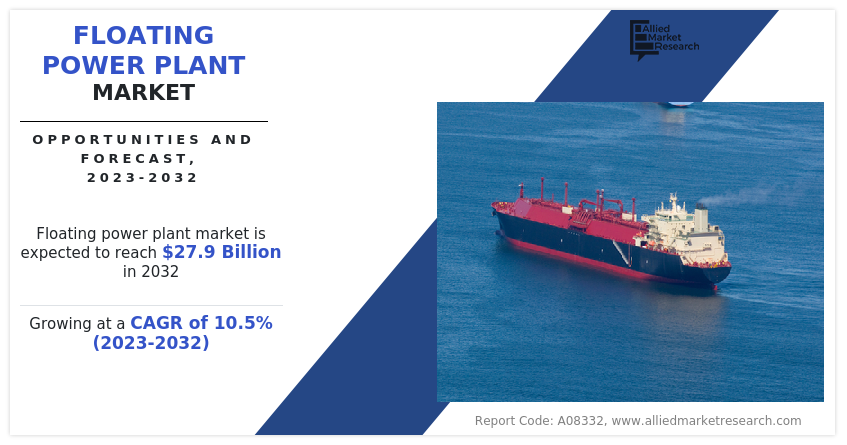
A floating power plant refers to a facility that generates electricity while being situated on a body of water, such as a river, lake, reservoir, or offshore in the ocean. These floating power plants can be designed to harness various energy sources, including floating solar power plants, floating wind farms, floating LNG (liquefied natural gas) power plants, hydroelectric power plants, wave and tidal energy converters, and nuclear power plants.
Rapid industrialization and urbanization observed in many regions around the world are driving the floating power plant market growth.
The need for decentralized power generation is accentuated in urban and industrial areas. Floating power plants offer a decentralized solution that can be deployed closer to areas of demand, reducing the need for extensive transmission infrastructure. Urban centers experience high energy demand due to concentrated industrial and commercial activities, as well as residential needs. Floating power plants, especially solar and wind installations, provide an additional source of clean energy to meet growing urban demands.
Furthermore, floating power plants can be integrated with existing industrial infrastructure, such as water treatment facilities, providing a dual-use solution. This integration supports energy generation while complementing other essential processes. As cities strive for sustainability and resilience, floating power plants align with these goals. They offer a clean energy solution that minimizes the environmental impact and contributes to urban resilience in the face of climate change. Floating solar power plants, in particular, provide a cooling effect on water bodies. In urban areas, where heat islands can be a concern, this cooling effect contributes to improved environmental conditions and can enhance the efficiency of solar panels.
The ability of floating power plants to be easily relocated provides flexibility in responding to changing energy demands and allows for optimal utilization of resources. This mobility is especially valuable in dynamic energy markets. Besides, floating power plants, particularly those using renewable energy sources, contribute to global efforts to reduce greenhouse gas emissions and combat climate change. Governments and organizations worldwide are increasingly focused on adopting cleaner energy technologies. These key drivers collectively contribute to the growth and adoption of floating power plants in coming years. However, the technological complexity and cost challenges are expected to act as a major restraint for market growth. Nevertheless, the technological advancement is anticipated to offer many opportunities for market growth in the coming years.
The floating power plant market is segmented on the basis of type of power source, capacity, deployment, application, and region. By power source, the market is categorized into renewable power source and non-renewable power source. By capacity, the market is categorized into 1–5 MW, 5.1–20 MW, 20.1–100 MW, 100.1–250 MW, and above 250 MW. As per deployment, the market is categorized into ship, barges, modular raft, and others. According to application, the market is categorized into manmade water bodies and natural water bodies. Region wise, the floating power plant market share is analyzed across North America, Europe, Asia-Pacific, and LAMEA.
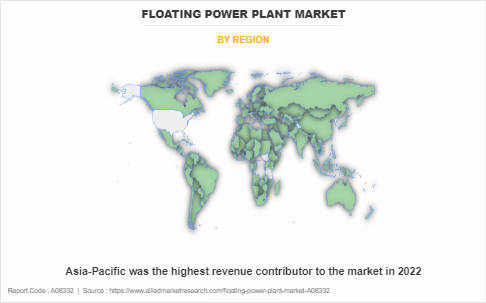
Asia-Pacific was the highest revenue contributor to the market in 2022. The Asia-Pacific region is characterized by rapid economic growth and urbanization. As energy demand increases, there is a need for innovative and sustainable solutions to meet the growing electricity needs. Many countries in the Asia-Pacific region are actively pursuing a transition to renewable energy sources. Floating power plants, particularly those utilizing solar and wind technologies, contribute to the diversification of the energy mix and help meet renewable energy targets.
Moreover, the region has seen significant growth in floating solar installations. With abundant water bodies such as reservoirs, ponds, and lakes, countries in the region are leveraging these water resources for efficient solar power generation. Some countries in the Asia-Pacific region are exploring offshore wind energy development. Floating wind turbines, designed for deeper waters, offer opportunities to harness wind energy in offshore environments.
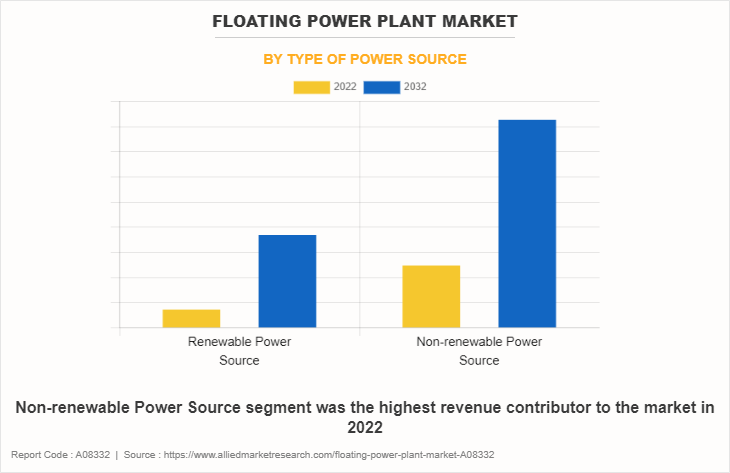
Non-renewable Power Source segment was the highest revenue contributor to the market in 2022. Non-renewable power sources, such as natural gas or diesel generators, can provide a stable and consistent base load power supply. In situations where a constant and reliable power output is crucial, non-renewable sources may be preferred. Some industries with high energy demands, such as heavy manufacturing or certain types of processing plants, may require a continuous and substantial power supply. Non-renewable power sources could be considered for such applications.
Gas turbines can be utilized as a non-renewable power source in floating power plants, particularly for electricity generation. Gas turbine systems are versatile and widely used in power generation due to their efficiency, quick start-up capabilities, and suitability for various applications. Internal Combustion (IC) engines can be used as a non-renewable power source in floating power plants. Internal combustion engines operate by burning fuel within the engine itself to produce mechanical energy, which is then converted into electricity through a generator.
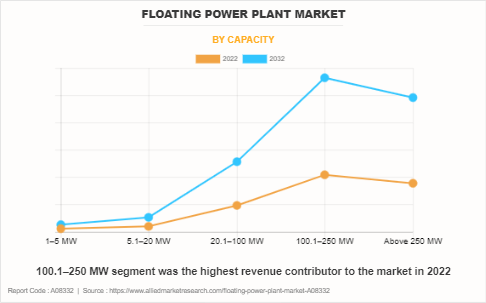
100.1–250 MW segment was the highest revenue contributor to the market in 2022. Countries and regions worldwide are setting ambitious renewable energy targets to reduce carbon emissions. 100.1–250 MW floating power plants contribute significantly to achieving these targets by providing a stable and scalable renewable energy source. Growing commitments to transition away from fossil fuels and embrace cleaner energy sources contribute to the demand for 100.1–250 MW floating power plants as part of diversified and sustainable energy portfolios. Also, advances in renewable energy technologies, particularly in the design of larger and more efficient turbines and solar arrays, enhance the feasibility and efficiency of these high-capacity floating power plants.
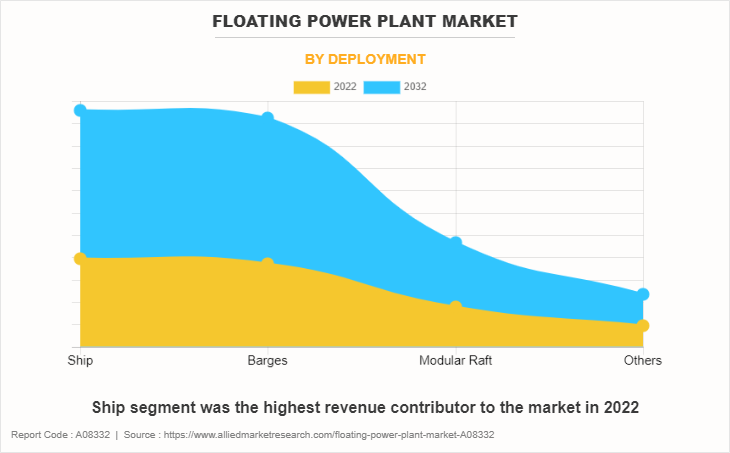
Ship segment was the highest revenue contributor to the market in 2022. Floating power ships can be rapidly deployed to areas with urgent energy needs. This makes them suitable for providing temporary power in emergency situations, disaster-stricken regions, or areas with insufficient electricity infrastructure. Floating power ships offer flexibility in terms of location and mobility. They can be moved to different regions or ports, adapting to changing energy demands or responding to specific events or projects.
Islands and remote coastal areas often face challenges in establishing traditional power infrastructure. Floating power ships provide a quick and flexible solution for meeting the energy needs of such regions without the need for extensive land-based installations. Floating power ships can support existing power infrastructure during maintenance or construction work. They can supply additional electricity to the grid during peak demand periods or when traditional power plants are offline for maintenance.
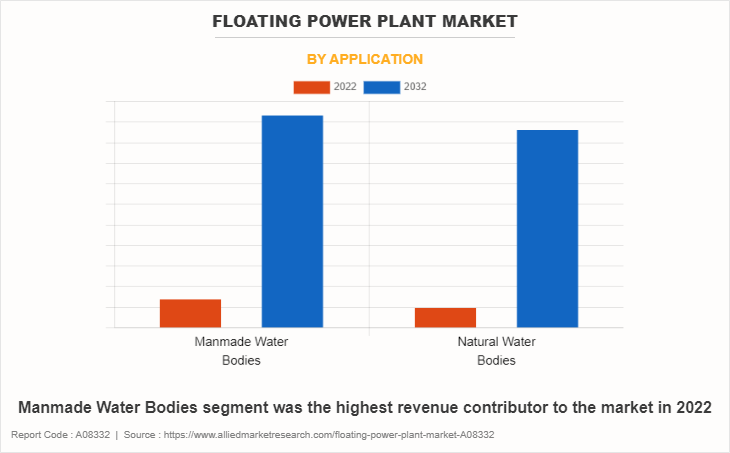
Manmade Water Bodies segment was the highest revenue contributor to the market in 2022. Using floating power plants on manmade water bodies presents various opportunities for energy generation. Manmade water bodies, such as reservoirs, ponds, and artificial lakes, provide unique environments for utilizing floating power technologies.
Furthermore, using floating solar power plants on manmade water bodies helps conserve water by reducing evaporation. The shading effect of solar panels on the water surface can minimize water loss, making it an environmentally friendly solution. There is a growing recognition of the interconnection between energy and water resources. Utilizing manmade water bodies for power generation contributes to a more integrated and sustainable approach to managing these resources.
Key players in the floating power plant industry include Wartsila, Kyocera Corporation, Yingli Solar, MAN Diesel and Turbo SE, Mitsubishi Corporation, SUNGROW, SolarisFloat, LLC, Profloating BV, NRG ISLAND s.r.l., ISIFLOATING, LLC, Oceans of Energy, LLC, Swimsol GmbH, Ideol, Floating Power Plant A/S, Principle Power, Inc., Vikram Solar Pvt., Ltd., Upsolar, SCOTRA CO, LTD., Siemens, General Electric, and Ciel and Terre International.
Key Benefits For Stakeholders
- This report provides a quantitative analysis of the market segments, current trends, estimations, and dynamics of the floating power plant market analysis from 2022 to 2032 to identify the prevailing floating power plant market opportunities.
- The floating power plant market forecast and research are offered along with information related to key drivers, restraints, and opportunities.
- Porter's five forces analysis highlights the potency of buyers and suppliers to enable stakeholders make profit-oriented business decisions and strengthen their supplier-buyer network.
- In-depth analysis of the floating power plant market segmentation assists to determine the prevailing market opportunities.
- Major countries in each region are mapped according to their revenue contribution to the global market.
- Market player positioning facilitates benchmarking and provides a clear understanding of the present position of the market players.
- The report includes the analysis of the regional as well as global floating power plant market trends, key players, market segments, application areas, and market growth strategies.
Floating Power Plant Market Report Highlights
| Aspects | Details |
| Market Size By 2032 | USD 27.9 billion |
| Growth Rate | CAGR of 10.5% |
| Forecast period | 2022 - 2032 |
| Report Pages | 450 |
| By Type of Power Source |
|
| By Capacity |
|
| By Deployment |
|
| By Application |
|
| By Region |
|
| Key Market Players | MAN Energy Solutions, KYOCERA Corporation, Profloating BV, VIKRAM SOLAR LTD., ISIFLOATING, LLC, General Electric, NRG ISLAND s.r.l., Oceans of Energy, BW Ideol, SUNGROW, Wartsila, Principle Power, SolarisFloat, LLC, Floating Power Plant A/S, Siemens, Ciel & Terre, Yingli Solar, Swimsol, Upsolar, Mitsubishi Corporation, SCOTRA CO, LTD. |
Analyst Review
According to the opinions of various CXOs of leading companies, the floating power plant market is expected to witness increased demand during the forecast period. Floating wind farms enable the deployment of wind turbines in deeper waters where fixed-bottom structures are not feasible. This opens up new possibilities for harnessing offshore wind energy in locations with strong and consistent winds.
Moreover, floating power plants can have a lower environmental impact compared to traditional land-based power plants. For example, floating solar farms can reduce water evaporation in reservoirs, and floating wind farms may have less impact on land ecosystems. Floating power plants, particularly those utilizing renewable energy sources, contribute to the reduction of greenhouse gas emissions. This aligns with global efforts to mitigate climate change and transition to more sustainable energy systems.
Further, as technology continues to evolve, there is potential for breakthroughs that significantly enhance the capabilities and cost-effectiveness of floating power plants. This creates exciting opportunities for the industry to contribute more substantially to global energy needs while mitigating environmental impacts.
Surge in demand for renewable energy is driving the market growth.
Asia-Pacific is the largest regional market for Floating Power Plant.
Manmade Water Bodies is the leading application of Floating Power Plant Market.
Key players in the floating power plant industry include Wartsila, Kyocera Corporation, Yingli Solar, MAN Diesel and Turbo SE, Mitsubishi Corporation, SUNGROW, SolarisFloat, LLC, Profloating BV, NRG ISLAND s.r.l., ISIFLOATING, LLC, Oceans of Energy, LLC, Swimsol GmbH, Ideol, Floating Power Plant A/S, Principle Power, Inc., Vikram Solar Pvt., Ltd., Upsolar, SCOTRA CO, LTD., Siemens, General Electric, and Ciel and Terre International.
The global floating power plant market size was valued at $10.3 billion in 2022, and is projected to reach $27.9 billion by 2032, growing at a CAGR of 10.5% from 2023 to 2032.
Loading Table Of Content...
Loading Research Methodology...



